HebNet CIC: The Small Isles & Knoydart, Scotland
INTRODUCTION
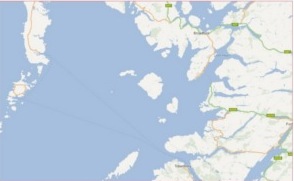
Eigg is one of the Small Isles, along with Muck, Rum & Canna, lying to the south of Skye, north west of Ardnamurchan Point. These islands have very small populations, Eigg is 90 odd, Muck & Rum around 30 each, & Canna just 12. They are served by a ferry from Mallaig, but physical communication with the mainland is often cut off for a week or more in the winter with bad weather. Good telecommunication is therefore vital. There is a telephone service, but it is incapable of supporting internet access. It is often incapable of supporting a phone call, but that is another story. The argument for good broadband access as an essential requirement in remote communities such as ours is now generally accepted, so won’t be repeated here.
A BRIEF HISTORY OF BROADBAND ON EIGG & THE SMALL ISLES
Until around 2005 we were dependent on narrowband dial-up. Then HIE promoted a hybrid terrestrial/satellite scheme called Hi-Wide, in which each community had a central satellite broadband connection, and a wireless network for local cover. It was OK when it worked, with speeds up to 750kbps on a good day. However it was a bit before its time in that the equipment used was not as stable as the kit we use now, and the network wasn't very well designed in that it had used some self-powered relay masts (wind/solar) in the chain which weren't reliable. The main problem though was that the satellite companies they used kept going out of business, leaving us suddenly with no service for months on end.
In 2008 there was a major government backed promotion of Avanti as a satellite provider to the remote areas of the Highlands. This proved more reliable than Hi-Wide, but it was very expensive at £24 per month for 512kbps. In practice you rarely saw those speeds except in the first month or so of connection. The disadvantages of satellite provision are also well known, particularly its inability to support VOIP services such as Skype, because of the very high and unavoidable latency, or round-trip time. We also found it performed very badly in poor weather — something of an issue in our part of the world.
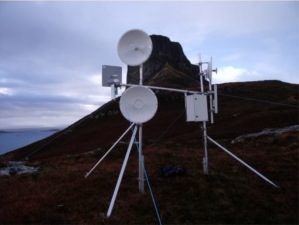
Early Sgurr mast
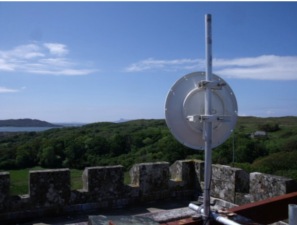
Church tower
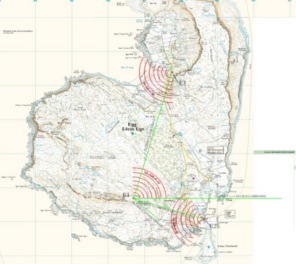
Early Eigg layout
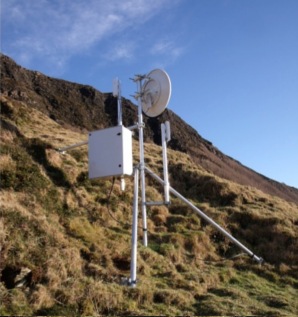
Cleadale mast
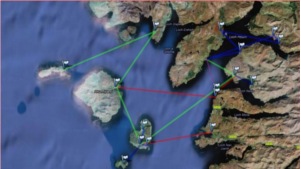
HebNet map
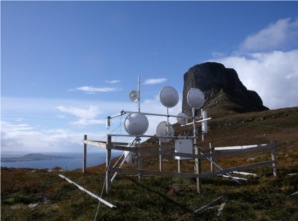
Sgurr mast now
Finally in April 2010 we made contact with Peter Buneman, and with his considerable help a pilot wireless network was established on Eigg, following the model they had pioneered with the Tegola project in Loch Hourn.
We had initially hoped to get backhaul from the Pathfinder network, which is government sponsored and channels significant bandwidth to secondary schools. In particular, Mallaig High School, where had the full co-operation of the headmaster and his IT staff, and we set up a successful trial link from there to our main relay mast high on the hill near the Sgurr of Eigg. However, when we asked Highland Council for their blessing, they saw it as a major threat to national security, or at least their own security, and refused us access to this obvious and underutilised backhaul. So we fell back on using an 8 Mbps business ADSL line from Arisaig exchange, 10 miles away on the mainland. The priest at the Catholic Church there generously allowed us to put a dish at the top of the church tower, and install our equipment and a phone line. We soon had a link established to Eigg, and a dozen or so houses connected in a pilot network.
In June that year a Community Interest Company, HebNet CIC was formed for the express purpose of providing fast, reliable and economic broadband to the communities of Eigg, Rum, Muck and Canna (the Small Isles) and Knoydart. By the end of that year most of Eigg's 50 or so households & businesses had been connected, and the number of ADSL lines increased to 3. By then Ian Bolas had joined us — he had been working in IT and networking, and was about to move up to Rum, and this was a huge boost for us. Soon 11 households on the Isle of Muck were connected, and a 4th line added for increased backhaul (we have found that a ratio of around 15 subscribers to one 8Mbps ADSL line gives good service without excessive contention.
Later in 2011 the Isle of Rum was connected, using a line from Mallaig exchange, and just recently a link to Rum via Elgol (Skye) to Canna has been installed, giving the residents of Canna a connection. Davie Newton, the project development officer on Knoydart, built the whole network there, in close collaboration with us, with backhaul via 3 lines in Mallaig. HebNet now have over 120 subscribers in these very remote parts of the west of Scotland. We have a connection fee of £75 plus a monthly subscription of £15. Any profits from the CIC are passed up to the parent community associations (all charities) of the individual communities.
In the summer of 2012 we joined forces with the Loch Hourn Community network (Tegola), and came to an agreement with Sabhal Mor Ostaig to take backhaul from the JANET network that supplies the college itself. It is only recently that JANET has been permitted to supply external non-academic networks on a commercial basis. We have also come to a commercial arrangement with Marine Harvest, whose local installations are served by our network, to cover the cost of the backhaul from SMO. So HebNet CIC and Tegola now have a backhaul source of over 30Mbps, a speed unimaginable on Eigg barely a year ago. This is effectively superfast broadband.
What impact has HebNet CIC had?
- Given all households decent broadband access (fast, economic & reliable)
- Opened up possibilities for distance learning for adults (e.g. access to UHI!)
- School pupils can log in from home — the GLOW project (Scottish schools national intranet) can be accessed
- Localbusinesses are no longer disadvantaged
- Social networking has become possible
- Local government online services are now available
- Potential for medical care has improved enormously
- A simple model for rural community broadband has been developed that is replicable almost anywhere
What are the benefits of a community network?
- Ability to set your own pricing — connection fee and monthly subscription
- Ability to decide how much bandwidth you receive
- For support you call a local resident, not a call centre
- More money stays in the local economy
- Opens up job opportunities and home based employment
- New revenue streams can be generated from local wi-fi “hot-spots” that visitors can access, after making a small payment to log into the network
- Backhaul can be purchased on a commercial scale — not possible for individuals
How could Scottish Government help in establishing more community networks?
- Set up a dedicated fund.
- Require the operators of communication masts (BT etc) to allow affordable access by local communities for their own small antennae.







